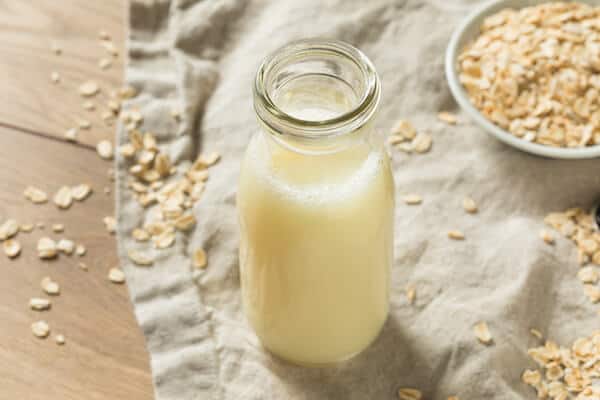If you’re a fan of ice cream, you’ve probably noticed the rise of plant-based milk options in recent years. Oat milk and almond milk are two of the most popular plant-based milk alternatives out there, but which one is better for ice cream?
In this article, we’ll explore the nutritional profile, flavor and texture, and sustainability of oat milk and almond milk to determine which one reigns supreme in the world of ice cream.
Let’s start by looking at the nutritional profile of oat milk and almond milk.
Both types of milk are generally lower in calories and fat than traditional dairy milk, making them a popular choice among health-conscious consumers.
Almond milk ice cream is typically higher in carbohydrates than oat milk ice cream, but it’s also a good source of vitamin E. Oat milk ice cream, on the other hand, is a great source of fiber, which can help keep you feeling full and satisfied longer.

Nutritional Profile of Oat Milk Ice Cream vs Almond Milk Ice Cream
When it comes to ice cream, the nutritional content of the milk used can affect the final product.
Oat milk has a slightly thicker consistency than almond milk, which can help create a creamier texture in ice cream. However, almond milk has a more subtle flavor than oat milk, which can allow other ingredients in the ice cream to shine.
When it comes to choosing a plant-based milk, it’s important to consider the nutritional profile. Oat milk and almond milk are both great options for those looking to reduce their dairy intake.
Almond milk is higher in calories and carbohydrates than oat milk, but it’s a good source of vitamin E. Oat milk, on the other hand, is lower in calories and carbohydrates, but it’s a good source of fiber. When it comes to ice cream, the nutritional content of the milk used can affect the final product. Almond milk’s higher fat content can help create a creamier texture, while oat milk’s lower calorie content can help keep the overall calorie count of the ice cream lower.
Calories and Nutrients In Oat Milk and Almond Milk
When it comes to calories and nutrients, oat milk and almond milk have some key differences. One cup of oat milk contains around 130 calories, <1 gram of protein, and 21 grams of carbohydrates.
One cup of almond milk contains around 200 calories, 2 grams of protein, and 27 grams of carbohydrates.
Oat milk is also a good source of fiber, with around 2 grams per cup, while almond milk contains vitamin E, with around 20% of the recommended daily value per cup.
These differences in nutrient content can affect the final product when making ice cream with plant-based milk alternatives.

Flavor and Texture of Oat Milk and Almond Milk in Ice Cream
Now, let’s move on to the flavor and texture of oat milk and almond milk in ice cream.
The Nutty and Neutral Flavors of Oat Milk and Almond Milk
When it comes to the flavor of plant-based milk, oat milk and almond milk have some key differences. Oat milk has a slightly nutty flavor that can work well in desserts, but it can also be overpowering if used in large quantities.
Almond milk, on the other hand, has a more neutral flavor that won’t overpower other ingredients in the ice cream. This makes it a great option if you’re looking to showcase other flavors, such as chocolate or vanilla, in your ice cream. Ultimately, the flavor of the milk used in ice cream is a matter of personal preference.
The Creamy and Icy Textures of Oat Milk and Almond Milk
In addition to flavor, the texture of plant-based milk can also affect the final product when making ice cream. Oat milk is thicker than almond milk and can help create a smoother, creamier ice cream.
Almond milk, on the other hand, is thinner than oat milk and can create a slightly icier texture in ice cream.
The texture of the milk used can also affect the overall mouthfeel of the ice cream. If you prefer a creamier, smoother ice cream, oat milk might be the way to go. If you don’t mind a slightly icier texture, almond milk could be a good choice.
Sustainability of Oat Milk and Almond Milk Production
Now, let’s talk about the sustainability of oat milk and almond milk production. Both types of milk have a lower environmental impact than traditional dairy milk, but there are some differences between the two.
The Environmental Impact of Oat Milk and Almond Milk Production
Oat milk production requires less water than almond milk production, which is an important consideration given the ongoing water scarcity issues in many parts of the world. Additionally, oat milk is often produced using locally-sourced ingredients, which can help reduce the carbon footprint of transportation.
Almond milk production, on the other hand, has been criticized for its water usage. Almonds require a lot of water to grow, and much of the almond milk on the market is produced in drought-prone regions of California. However, there are some efforts underway to make almond milk production more sustainable, such as using recycled water and more efficient irrigation systems.
So, which one is more sustainable? It’s a complicated question with no easy answer. Both oat milk and almond milk have their pros and cons when it comes to environmental impact. However, if sustainability is an important consideration for you, it’s worth doing some research to find out more about the specific brands you’re considering and their production methods.

A Delicious and Sustainable Future for Ice Cream
The rise of plant-based milk alternatives in the ice cream industry represents a significant shift towards a more sustainable and ethical food system. Plant-based milk is a more environmentally friendly option than traditional dairy milk, which is one of the biggest contributors to greenhouse gas emissions and other environmental problems.
Additionally, plant-based milk can be a more ethical option for those concerned about animal welfare, as it does not require the use of dairy cows. By choosing plant-based milk for ice cream, consumers can enjoy a delicious treat that is also healthier, more sustainable, and more ethical. As plant-based milk continues to gain popularity, we can expect to see even more innovative and delicious plant-based ice cream options in the future.
Final Thoughts
It’s worth noting that there are other plant-based milk options out there besides oat milk and almond milk, such as soy milk and coconut milk. These alternatives can also be used in ice cream and have their own unique nutritional profiles, flavors, and textures.
So, if you’re looking to experiment with plant-based milk in your ice cream, don’t be afraid to try different options.
Oat milk and almond milk are both viable options for ice cream, and the choice between the two ultimately comes down to personal preference. Whether you prefer the nutty flavor and creamier texture of oat milk, or the neutral flavor and icier texture of almond milk, there’s a plant-based milk out there for everyone.
And with the growing availability and popularity of plant-based milk, we can all enjoy ice cream that is not only delicious but also healthier and more sustainable. So go ahead and indulge in a scoop of plant-based milk ice cream guilt-free!
Which Plant-Based Milk Makes The Most Delicious Ice Cream?
So, which one is better for ice cream? Both oat milk and almond milk have their advantages and disadvantages when it comes to ice cream. Oat milk can create a creamier texture, but it has a stronger flavor that might not be to everyone’s liking. Almond milk has a more neutral flavor, but it can create a slightly icier texture in ice cream. Ultimately, the choice comes down to personal preference and the specific recipe being used.
Recent Posts
If you're lactose intolerant, vegan, or simply looking for a healthier alternative to traditional dairy ice cream, oat milk ice cream may be just what you're looking for. But how does it compare to...

